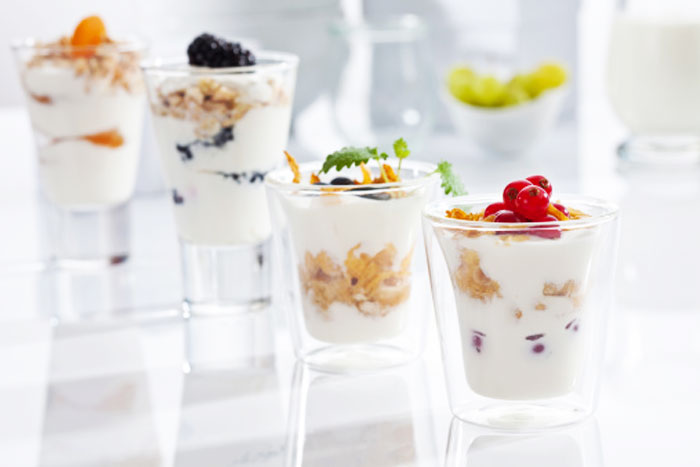
Written By: Gloria Tsang, RD
Title: Founding Registered Dietitian
Alumni: University of British Columbia
Last Updated on:

Yogurt has become a breakfast staple, particularly in hot summer days. As the yogurt aisle is filled with various options, how do we go about choosing an ideal product for our own nutritional needs?

Table of Contents
For a yogurt to be a good source of calcium, it needs to contain at least 20% Daily Value (% DV) for calcium. In order to obtain this amount, the standard serving size is a typical 6-oz serving. If you purchase individually-packed yogurt, many brands only provide 3 to 4 ounce per serving. Some kids’ and baby yogurt products even come in 2- or 3-oz servings! We see a place for small portions when it comes to portioning for babies or very young children, but older children or adults can typically eat more. If you are eating yogurt as a milk alternative, very small portions of yogurt may not supply a sufficient amount of calcium to the diet. The best option is to purchase family size – so we can scoop out whatever we need.
There has been an explosion of Greek yogurts on the market. However, they are not all created equal.
Natural, unsweetened greek yogurt has low glycemic index value (GI ~12). If managing blood sugar is one of health benefits you are aiming for, beware when choosing flavored version. Even you don’t see “sugar” on the ingredient list, other terms such as “fructose” or “evaporated cane juice” as well as honey and maple syrup are all considered as added sugar. These are all sweeteners and do ramp up the grams of sugar you will find on the Nutrition Facts panel.
If you’re traveling cross border this summer, don’t assume the ingredients and nutritional profile is the same, even under the same brand name. For a given brand and manufacturer, the U.S. and Canadian products may be different. Take the example of Fat-Free Danone Oikos Strawberry (Canadian) and Non-Fat Danone Oikos Strawberry (US). Both are %MF greek yogurt; the Canadian product has cornstarch and carrageenan as thickeners, while the American product has pectin as thickeners. Perhaps due to more thickeners, the carbohydrate content is higher in Canadian version.
We find that the labels “light” or “low-sugar” tend to signal the presence of artificial sweeteners. In the past, most artificially sweetened yogurt products are sweetened with sucralose and sometime sweetened with two or more artificial sweeteners. For instance, Yoplait Light is sweetened with allulose, sucralose, and asesulfame potassium. As consumers nowadays demand more natural sweeteners, some products are now sweetened with stevia, such as Two Good (also known as Too Good in the US).
Do your research before visiting the yogurt section at the supermarket; the market has really exploded and weeding through the selection can be quite mind-boggling!
Here are a few quick things to look for when choosing a yogurt:
Alumni: University of British Columbia – Gloria Tsang is the author of 6 books and the founder of HealthCastle.com, the largest online nutrition network run by registered dietitians. Her work has appeared in major national publications, and she is a regularly featured nutrition expert for media outlets across the country. The Huffington Post named her one of its Top 20 Nutrition Experts on Twitter. Gloria’s articles have appeared on various media such as Reuters, NBC & ABC affiliates, The Chicago Sun-Times, Reader’s Digest Canada, iVillage and USA Today.
grocery aisle, kid's nutrition, yogurt
IS plain Greek yogurt with 0% MF is good?